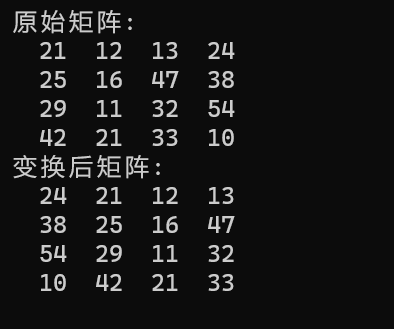实验4
任务1
1.1
代码
1 #include <stdio.h> 2 #define N 4 3 4 void test1() { 5 int a[N] = {1, 9, 8, 4}; 6 int i; 7 8 printf("sizeof(a) = %d\n", sizeof(a)); 9 10 for (i = 0; i < N; ++i) 11 printf("%p: %d\n", &a[i], a[i]); 12 13 printf("a = %p\n", a); 14 } 15 16 void test2() { 17 char b[N] = {'1', '9', '8', '4'}; 18 int i; 19 20 printf("sizeof(b) = %d\n", sizeof(b)); 21 22 for (i = 0; i < N; ++i) 23 printf("%p: %c\n", &b[i], b[i]); 24 25 printf("b = %p\n", b); 26 } 27 28 int main() { 29 printf("测试1: int类型一维数组\n"); 30 test1(); 31 32 printf("\n测试2: char类型一维数组\n"); 33 test2(); 34 35 return 0; 36 }
运行截图
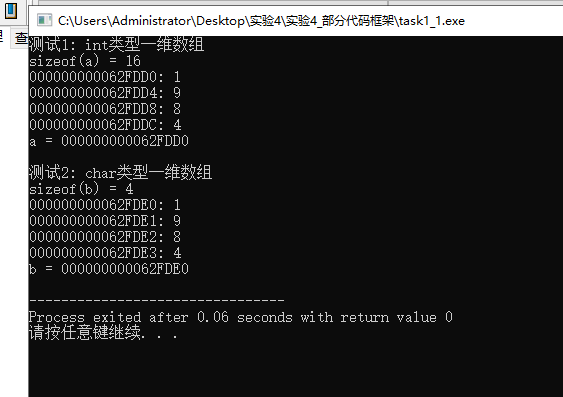
答问题:
1.是;4;是。
2.是;1;是。
1.2
代码
1 #include <stdio.h> 2 #define N 2 3 #define M 4 4 5 void test1() { 6 int a[N][M] = {{1, 9, 8, 4}, {2, 0, 4, 9}}; 7 int i, j; 8 9 printf("sizeof(a) = %d\n", sizeof(a)); 10 11 for (i = 0; i < N; ++i) 12 for (j = 0; j < M; ++j) 13 printf("%p: %d\n", &a[i][j], a[i][j]); 14 printf("\n"); 15 16 printf("a = %p\n", a); 17 printf("a[0] = %p\n", a[0]); 18 printf("a[1] = %p\n", a[1]); 19 printf("\n"); 20 } 21 22 void test2() { 23 char b[N][M] = {{'1', '9', '8', '4'}, {'2', '0', '4', '9'}}; 24 int i, j; 25 26 printf("sizeof(b) = %d\n", sizeof(b)); 27 28 for (i = 0; i < N; ++i) 29 for (j = 0; j < M; ++j) 30 printf("%p: %c\n", &b[i][j], b[i][j]); 31 printf("\n"); 32 33 printf("b = %p\n", b); 34 printf("b[0] = %p\n", b[0]); 35 printf("b[1] = %p\n", b[1]); 36 } 37 38 int main() { 39 printf("测试1: int型两维数组"); 40 test1(); 41 42 printf("\n测试2: char型两维数组"); 43 test2(); 44 45 return 0; 46 }
运行截图
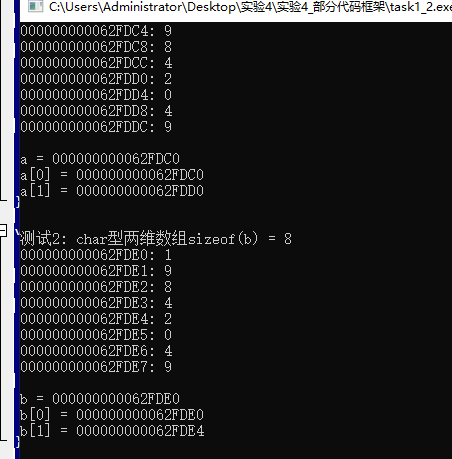
问题回答:
1.是;4;是
2.是;1;是
3.相差16;相差4;是一个一位数组的大小。
任务2.
代码
1 #include <stdio.h> 2 #include <string.h> 3 4 #define N 80 5 6 void swap_str(char s1[N], char s2[N]); 7 void test1(); 8 void test2(); 9 10 int main() { 11 printf("测试1: 用两个一维char数组,实现两个字符串交换\n"); 12 test1(); 13 14 printf("\n测试2: 用二维char数组,实现两个字符串交换\n"); 15 test2(); 16 17 return 0; 18 } 19 20 void test1() { 21 char views1[N] = "hey, C, I hate u."; 22 char views2[N] = "hey, C, I love u."; 23 24 printf("交换前: \n"); 25 puts(views1); 26 puts(views2); 27 28 swap_str(views1, views2); 29 30 printf("交换后: \n"); 31 puts(views1); 32 puts(views2); 33 } 34 35 void test2() { 36 char views[2][N] = {"hey, C, I hate u.", 37 "hey, C, I love u."}; 38 39 printf("交换前: \n"); 40 puts(views[0]); 41 puts(views[1]); 42 43 swap_str(views[0], views[1]); 44 45 printf("交换后: \n"); 46 puts(views[0]); 47 puts(views[1]); 48 } 49 50 void swap_str(char s1[N], char s2[N]) { 51 char tmp[N]; 52 53 strcpy(tmp, s1); 54 strcpy(s1, s2); 55 strcpy(s2, tmp); 56 }
运行结果
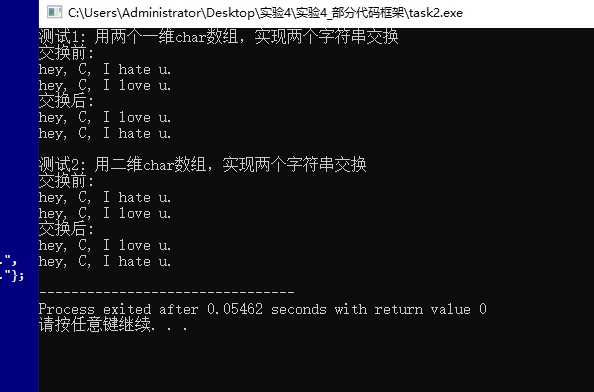
问题回答:
加不加[]都可以使用,数组在函数中起到指针的作用。
任务3
3.1
代码
#include <stdio.h> #define N 80 int count(char x[]); int main() { char words[N+1]; int n; while(gets(words) != NULL) { n = count(words); printf("单词数: %d\n\n", n); } return 0; } int count(char x[]) { int i; int word_flag = 0; int number = 0; for(i = 0; x[i] != '\0'; i++) { if(x[i] == ' ') word_flag = 0; else if(word_flag == 0) { word_flag = 1; number++; } } return number; }
运行结果
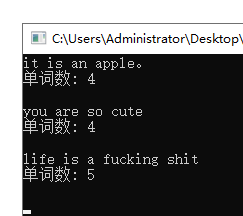
3.2
代码
1 #include <stdio.h> 2 #define N 1000 3 4 int main() { 5 char line[N]; 6 int word_len; 7 int max_len; 8 int end; 9 int i; 10 11 while(gets(line) != NULL) { 12 word_len = 0; 13 max_len = 0; 14 end = 0; 15 16 i = 0; 17 while(1) { 18 while(line[i] == ' ') { 19 word_len = 0; 20 i++; 21 } 22 23 24 while(line[i] != '\0' && line[i] != ' ') { 25 word_len++; 26 i++; 27 } 28 29 if(max_len < word_len) { 30 max_len = word_len; 31 end = i; 32 } 33 if(line[i] == '\0') 34 break; 35 } 36 37 printf("最长单词: "); 38 for(i = end - max_len; i < end; ++i) 39 printf("%c", line[i]); 40 printf("\n\n"); 41 } 42 43 return 0; 44 }
运行结果
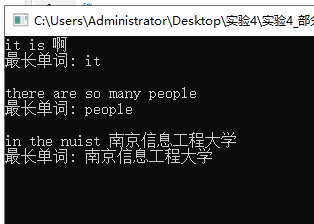
实验4
代码
1 #include <stdio.h> 2 #include <string.h> 3 #define N 100 4 5 void dec_to_n(int x, int n); 6 7 int main() { 8 int x; 9 printf("输入一个十进制整数: "); 10 while(scanf("%d", &x) != EOF) { 11 dec_to_n(x, 2); 12 dec_to_n(x, 8); 13 dec_to_n(x, 16); 14 15 printf("\n输入一个十进制整数: "); 16 } 17 18 return 0; 19 } 20 21 22 void dec_to_n(int x, int n) 23 { 24 int a[N]; 25 char t; 26 int i = 1; 27 28 memset(a,'\0',sizeof(a)); 29 while(x >= n) 30 { 31 a[i] = x%n; 32 x /= n; 33 i++; 34 } 35 a[i] = x; 36 37 for(;i > 0;i--) 38 { 39 if(a[i] == 10) 40 { 41 t = 'A'; 42 printf("%c",t); 43 } 44 else if(a[i] > 10) 45 { 46 t = 'A'+a[i]-10; 47 printf("%c",t); 48 } 49 else 50 { 51 printf("%d",a[i]); 52 } 53 } 54 printf("\n"); 55 }
运行结果
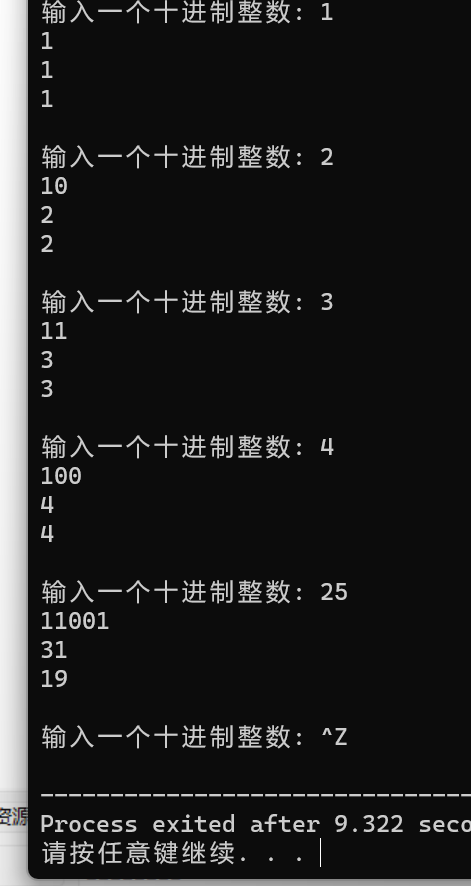
任务5
代码
1 #include <stdio.h> 2 #define N 5 3 4 // 函数声明 5 void input(int x[], int n); 6 void output(int x[], int n); 7 double average(int x[], int n); 8 void bubble_sort(int x[], int n); 9 10 int main() { 11 int scores[N]; 12 double ave; 13 14 printf("录入%d个分数:\n", N); 15 input(scores, N); 16 17 printf("\n输出课程分数: \n"); 18 output(scores, N); 19 20 printf("\n课程分数处理: 计算均分、排序...\n"); 21 ave = average(scores, N); 22 bubble_sort(scores, N); 23 24 printf("\n输出课程均分: %.2f\n", ave); 25 printf("\n输出课程分数(高->低):\n"); 26 output(scores, N); 27 28 return 0; 29 } 30 31 // 函数定义 32 // 输入n个整数保存到整型数组x中 33 void input(int x[], int n) { 34 int i; 35 36 for(i = 0; i < n; ++i) 37 scanf("%d", &x[i]); 38 } 39 40 // 输出整型数组x中n个元素 41 void output(int x[], int n) { 42 int i; 43 44 for(i = 0; i < n; ++i) 45 printf("%d ", x[i]); 46 printf("\n"); 47 } 48 49 double average(int x[], int n) { 50 int i, sum = 0; 51 for (i = 0; i < n; ++i) 52 sum += x[i]; 53 return (double)sum / n; 54 } 55 56 57 58 void bubble_sort(int x[], int n) { 59 int i, j, temp; 60 for (i = 0; i < n - 1; ++i) { 61 for (j = 0; j < n - 1 - i; ++j) { 62 if (x[j] < x[j + 1]) { 63 // 交换元素 64 temp = x[j]; 65 x[j] = x[j + 1]; 66 x[j + 1] = temp; 67 } 68 } 69 } 70 }
运行结果
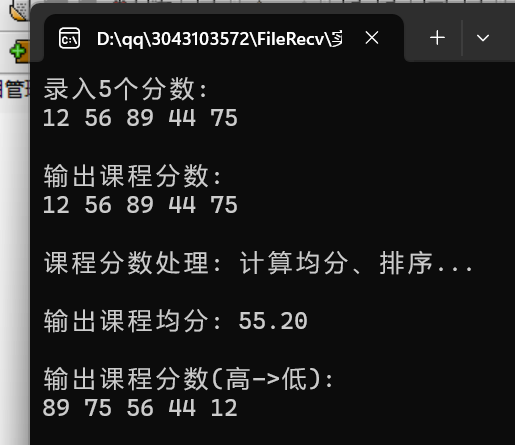
任务6
代码
1 #include <stdio.h> 2 #include <string.h> 3 #define N 5 4 #define M 20 5 6 // 函数声明 7 void output(char str[][M], int n); 8 void bubble_sort(char str[][M], int n); 9 10 int main() { 11 char name[][M] = {"Bob", "Bill", "Joseph", "Taylor", "George"}; 12 13 printf("输出初始名单:\n"); 14 output(name, N); 15 16 printf("\n排序中...\n"); 17 bubble_sort(name, N); // 函数调用 18 19 printf("\n按字典序输出名单:\n"); 20 output(name, N); 21 22 return 0; 23 } 24 25 // 函数定义 26 // 功能:按行输出二维数组中的字符串 27 void output(char str[][M], int n) { 28 int i; 29 for(i = 0; i < n; ++i) 30 printf("%s\n", str[i]); 31 } 32 33 // 函数定义 34 // 功能:使用冒泡排序算法对二维数组str中的n个字符串按字典序排序 35 void bubble_sort(char str[][M], int n) { 36 int i, j; 37 char temp[M]; 38 39 for (i = 0; i < n - 1; ++i) { 40 for (j = 0; j < n - i - 1; ++j) { 41 // 如果相邻的字符串顺序不对,交换它们 42 if (strcmp(str[j], str[j + 1]) > 0) { 43 strcpy(temp, str[j]); 44 strcpy(str[j], str[j + 1]); 45 strcpy(str[j + 1], temp); 46 } 47 } 48 } 49 }
运行结果
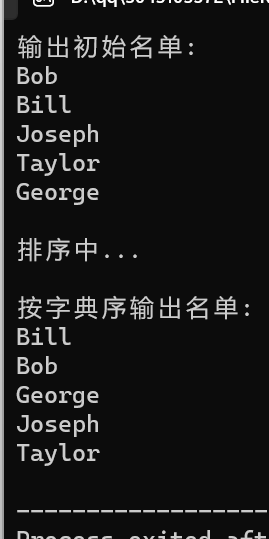
任务7
代码
1 #include <stdio.h> 2 3 int hasDuplicates(int num); 4 5 int main() { 6 int input; 7 char choice; 8 printf("请输入一个整数(1<= 整数数位 <=100):"); 9 while(scanf("%d",&input)!=EOF){ 10 11 if (hasDuplicates(input)) { 12 printf("YES,输入的整数包含重复出现的数字。\n"); 13 } else { 14 printf("NO,输入的整数没有重复出现的数字。\n"); 15 } 16 printf("请输入一个整数(1<= 整数数位 <=100):"); 17 } 18 19 return 0; 20 } 21 22 23 int hasDuplicates(int num) { 24 int digitCount[10] = {0}; 25 26 while (num > 0) { 27 int digit = num % 10; 28 29 if (digitCount[digit] > 0) { 30 return 1; 31 } 32 33 digitCount[digit]++; 34 num /= 10; 35 } 36 37 return 0; 38 }
运行结果
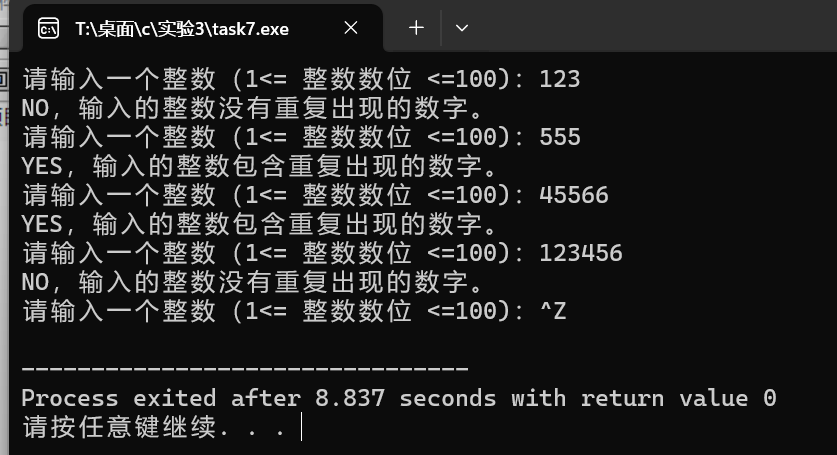
任务8
代码
1 #include <stdio.h> 2 #define N 100 3 #define M 4 4 5 void output(int x[][N], int n); 6 void rotate_to_right(int x[][N], int n); 7 8 int main() { 9 int t[][N] = { 10 {21, 12, 13, 24}, 11 {25, 16, 47, 38}, 12 {29, 11, 32, 54}, 13 {42, 21, 33, 10} 14 }; 15 16 printf("原始矩阵:\n"); 17 output(t, M); 18 19 rotate_to_right(t, M); 20 21 printf("变换后矩阵:\n"); 22 output(t, M); 23 24 return 0; 25 } 26 27 void output(int x[][N], int n) { 28 int i, j; 29 for (i = 0; i < n; ++i) { 30 for (j = 0; j < n; ++j) 31 printf("%4d", x[i][j]); 32 printf("\n"); 33 } 34 } 35 36 void rotate_to_right(int x[][N], int n) { 37 int temp[N]; 38 int i, j; 39 40 for (i = 0; i < n; ++i) { 41 // 将最后一列存储在temp中 42 temp[i] = x[i][n - 1]; 43 44 // 将每一列向右移动 45 for (j = n - 1; j > 0; --j) 46 x[i][j] = x[i][j - 1]; 47 48 // 将存储的列复制到第一列 49 x[i][0] = temp[i]; 50 } 51 }
运行结果
